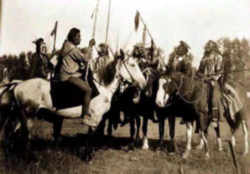


New York Early History
First Early Inhabitants of New York

Early history examines the archaeological record that tells the story of the first inhabitants of New York. Learn about the prehistory and culture of the first early inhabitants, and what lessons it might teach us about the early history of New York.
New York First Early Inhabitants Timeline
- 10,000 BC Paleo-Indian Era (Stone Age culture) the earliest human inhabitants of America who lived in caves and were Nomadic hunters of large game including the Great Mammoth and giant bison.
- 7000 BC Archaic Period in which people built basic shelters and made stone weapons and stone tools
- 1600 -1000 AD Woodland Period - homes were established along rivers and trade exchange systems and burial systems were established The ancestors of these natives entered the Hudson Valley some twelve thousand years ago, after the last continental glacier receded from North America. A significant change took place in the northeast from 1000 to 1600 AD as these early people gradually discovered they could grow their own vegetables. Horticulture, or garden farming, added to the traditional lifestyle of hunting, fishing and gathering. Corn, beans, squash and pumpkins, sunflowers and tobacco came from the south and southwest, perhaps initially from Mexico, where agriculture had been practiced for several thousand years.
- 1500s - 1600's - New York explored by Europeans from Great Britain, Sweden, Holland and France
- 1763 - 1675 -- Pontiac's Rebellion, Chief Pontiac's tries to force British out of the West, Michigan, New York and Pennsylvania.
- 1688 - 1763 - The French and Indian Wars between France and Great Britain for lands in North America consisting of King William's War (1688-1699), Queen Anne's War (1702-1713), King George's War (1744 - 1748) and the French and Indian War aka the Seven Years War (1754-1763)
- 1688 - (1688-1699) King William's War (part of the French and Indian Wars) between France and the Wabanaki Confederacy and England and the Iroquois Confederacy. Peace Treaty made at Pemaquid. August 11,1693. and was ratified on Jan. 7. 1699
- 1690 - Schenectady Massacre - French and Algonquins destroy Schenectady, New York, killing 60 settlers
- 1754 - 1763: The French Indian War is won by Great Britain against the French so ending the series of conflicts known as the French and Indian Wars
- 1778 - Cherry Valley Massacre - British and Seneca Indian forces attack a fort and village in eastern New York
Early History of Native Americans in New York
The Indigenous People of New York
The names of the New York tribes included the Delaware, Erie, Iroquois, Mohawk, Oneida and Seneca.
When the first European explorer sailed into New York harbor in 1524, the native civilization found on the banks of the Hudson was a complex and
ancient one. The natives' ancestors had entered the Hudson Valley some twelve thousand years earlier, after the last continental glacier receded from
North America.
A significant change took place in the northeast from 1000 to 1600 AD as these early people gradually discovered they could grow their own vegetables.
Horticulture, or garden farming, added to the traditional lifestyle of hunting, fishing and gathering. Corn, beans, squash and pumpkins, sunflowers
and tobacco came from the south and southwest, perhaps initially from Mexico, where agriculture had been practiced for several thousand years.
At the time of encounter with the Europeans, the natives densely populated the entire area in and around what is now New York City. On the banks of
the Hudson, as far north as Albany, Algonquin tribes lived in fortified villages, protected by sturdy walls of upright logs. According to early colonists
and explorers' journals, there were also many unfortified villages on both banks of the Hudson.
From the mid to late 1700s, the Indian population had gradually dwindled as the lower River Indians suffered from smallpox, malaria, influenza and
other diseases which were previously unknown to them. Entire villages were wiped out because the natives lacked immunity to the white man's diseases.
The Westchester Indians to the east of the river had sold most of their lands to the English by the early 1700s. Some remained in Yorktown around Indian
Hill. Some chose to stay in the Hudson Valley, settling in remote areas either marrying other remaining Indians or intermarrying with their black or
white neighbors. Most, however, moved west into Ohio, where they endured another century of struggle as white settlers spread beyond the Ohio River.
Some would return to their lands to trade furs they had trapped, to sell baskets and crafts door-to-door, to visit the graves of their ancestors and
to die in their homeland.





